| Srl | Item |
| 1 |
ID:
128199
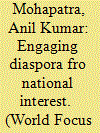

|
|
|
|
|
| Publication |
2014.
|
| Summary/Abstract |
The growing influence of diasporas on foreign affairs and the international behavior of the states has been a worldwide academic finding and a reported fact. As independent actors they have operated as lobbies which have actively influenced homeland (ancestral or kin-states) foreign policies and that of the host lands as well (Shain et al 2003). Especially the developing countries in their mission of development have tried to rope in their communities abroad in the process. This global phenomenon of diaspora-homeland linkage has debate on economic and political systems, national culture and international relations.
|
|
|
|
|
|
|
|
|
|
|
|
|
|
|
|
| 2 |
ID:
128139
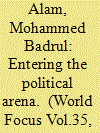

|
|
|
|
|
| Publication |
2014.
|
| Summary/Abstract |
The Indian community in United States is one among many ethnic communities, which have been increasingly visible in the last four decades. Although the flow of Indians as new ethnic started first as a trickle in 1895, their impact was really felt in the aftermath of the landmark 1965 immigration legislation. This new immigration groups has begun to attract academic attention and has to been the focus of research by a number of scholars.
|
|
|
|
|
|
|
|
|
|
|
|
|
|
|
|
| 3 |
ID:
128138
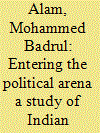

|
|
|
|
|
| Publication |
2014.
|
| Summary/Abstract |
The Indian community in United States is one among many ethnic communities, which have been increasingly visible in the last four decades. Although the flow of Indians as new ethnic started first as a trickle in 1895, their impact was really felt in the aftermath of the landmark 1965 immigration legislation. This new immigration groups has begun to attract academic attention and has to been the focus of research by a number of scholars.
|
|
|
|
|
|
|
|
|
|
|
|
|
|
|
|
| 4 |
ID:
073587


|
|
|
| 5 |
ID:
128290
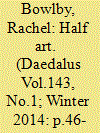

|
|
|
|
|
| Publication |
2014.
|
| Summary/Abstract |
In this piece. I look at an essay that l have probably read too often not to find in it the key to all matters
aesthetic, historical. philosophical, and more. The essay is Charles Baudelaire°s Le Peintre de la vie modeme (The Painter of Modern Life), first published in 1863 and written, most probably, around 1859 to 1860. Baudelaire's exhilarating innovation is to down- play the signi?cance of eternal value in art. in favor of what he designates as its other half, the ?eeting presentness that is modernity. My essay is unapologetically an appreciation - for the most part - of a text that, in focusing on another artist, itself appears to be just that.' For Baudelaire develops his arguments through a mock-anonymous celebration of the artist Constantine Guys, referred to as M. G. (Monsieur G.). Guys's proli?c sketches, done at speed, for rapid journal publication, chart the smallest of day-by- day changes and typical scenes in contemporary life. Guys's pictures - the art of modernity - give to the day a second life. and "translate" into a different medium - from sight to (mental) impression to its "rebirth" as a sketch - that which would otherwise be lost with its passing.
|
|
|
|
|
|
|
|
|
|
|
|
|
|
|
|
| 6 |
ID:
076744
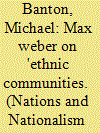

|
|
|
|
|
| Publication |
2007.
|
| Summary/Abstract |
An untitled draft found among Weber's posthumous papers was published. In English translation it was given the title `Ethnic Groups'. In the Max Weber Gesamtausgabe it is titled `Ethnic Communities'. In this manuscript, Weber treated the feeling of belonging together because of shared ethnic origin as a social construct, underlain by a desire to monopolise power and status. Subsequently, Weber determined to put an end to the use of collectivist concepts, but at the time of writing he treated groups as real entities, instead of using the concept of group as an aid in the explanation of behaviour. The causal connections in ethnic group formation and maintenance have been more closely identified in subsequent sociological analysis.
|
|
|
|
|
|
|
|
|
|
|
|
|
|
|
|
| 7 |
ID:
128289
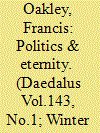

|
|
|
|
|
| Publication |
2014.
|
| Summary/Abstract |
The Leviathan is the greatest. Perhaps the sole. Masterpiece of political philosophy written in the English language. And the history of our civilization can provide only a few works of similar scope and achievement to set beside it. Consequently, it must be judged by none but the highest standards and must be considered only in the widest context. The masterpiece supplies a standard and a context for the second-rate. which indeed is but a gloss: but the context of the masterpiece itself. the setting in which its meaning is revealed. can in the nature of things be nothing narrower than the history of political philosophy.
|
|
|
|
|
|
|
|
|
|
|
|
|
|
|
|
| 8 |
ID:
129457
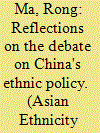

|
|
|
|
|
| Publication |
2014.
|
| Summary/Abstract |
'Minzu' (nation or nationality) is a term that appeared in China after the Opium Wars. From 1949, the PRC established a two-level national structure with the term 'minzu': the Chinese nation (zhonghua minzu) at the top and 56 nationalities (minzu) at the bottom. The PRC also adopted the Soviet model in regard to administration of and policies toward the minority 'minzu'. In recent years, amid increased tensions and conflicts among China's 'nationalities' (minzu), an ongoing debate among Chinese scholars has been observed. This paper reviews this debate and clarifies some misunderstandings among different viewpoints.
|
|
|
|
|
|
|
|
|
|
|
|
|
|
|
|
| 9 |
ID:
126658
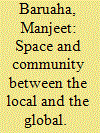

|
|
|
|
|
| Publication |
2013.
|
| Summary/Abstract |
The objective of this article is to situate the relation between the local and the global in the context of a specific region formation, namely the Brahmaputra Valley of Assam in India as a frontier. The article takes up two examples on the relation between space and community construct and how the relation forms part of the deeper relation between the local and the global in the Valley. The Brahmaputra Valley comprises the major area of the Indian state of Assam. Assam and its neighbouring areas are also referred to as 'North East India'. The term came into use during the colonial period. It was used to refer to the British-Indian frontier which bordered on Bhutan, Tibet, China and Myanmar. In the first example of the article, the local-global relation is seen in terms of how the colonial-capitalism paradigm altered the pre-colonial socio-spatial relation, formulating and implementing new spatial and social classifications. The focus in the example is on the rearrangement of socio-spatial relations in the Valley as part of transforming a pre-colonial crossroads into a colonial frontier. In the second example, the relation between space and community construct is situated in popular responses to the above changes, and especially how international ideology like communism is appropriated to address the local specificity of frontier. The works of the cultural icon and peasant leader of the Valley, Bishnu Rabha, are discussed in detail. Through the interrelation between the two examples, the article tries to show how between the nineteenth and the mid-twentieth century the local specificity of the Valley as a frontier was possible precisely due to changes of state formation or ideology which drew on a global context. In other words, the relation between space and community construct in the Valley demonstrates how the coexistence of the local and the global was a necessary condition in its making as a frontier. Community constructs like 'tribe', 'Assamese' and 'Ahom' during the period formed part of this interrelation between the local and the global that
|
|
|
|
|
|
|
|
|
|
|
|
|
|
|
|
| 10 |
ID:
130902
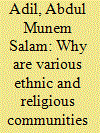

|
|
|
|
|
| Publication |
2014.
|
| Summary/Abstract |
I'm not going to cite precise figures and pass judgments or use demographic jargon. I think it is necessary to shed light on the phenomenon of massive migration to Europe from countries of the Middle East and North Africa that experienced the so-called Arab Spring and on possible ramifications for Russia in terms of economic and cultural adaptation of a fraction of these migrants from Europe to Russia already saddled with a colossal problem of illegal migrants.
|
|
|
|
|
|
|
|
|
|
|
|
|
|
|
|